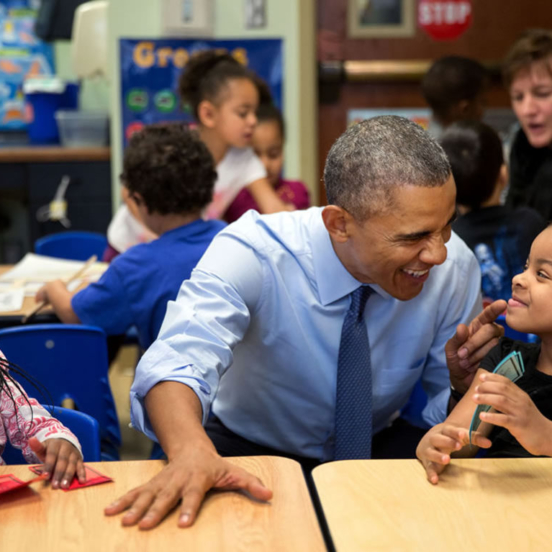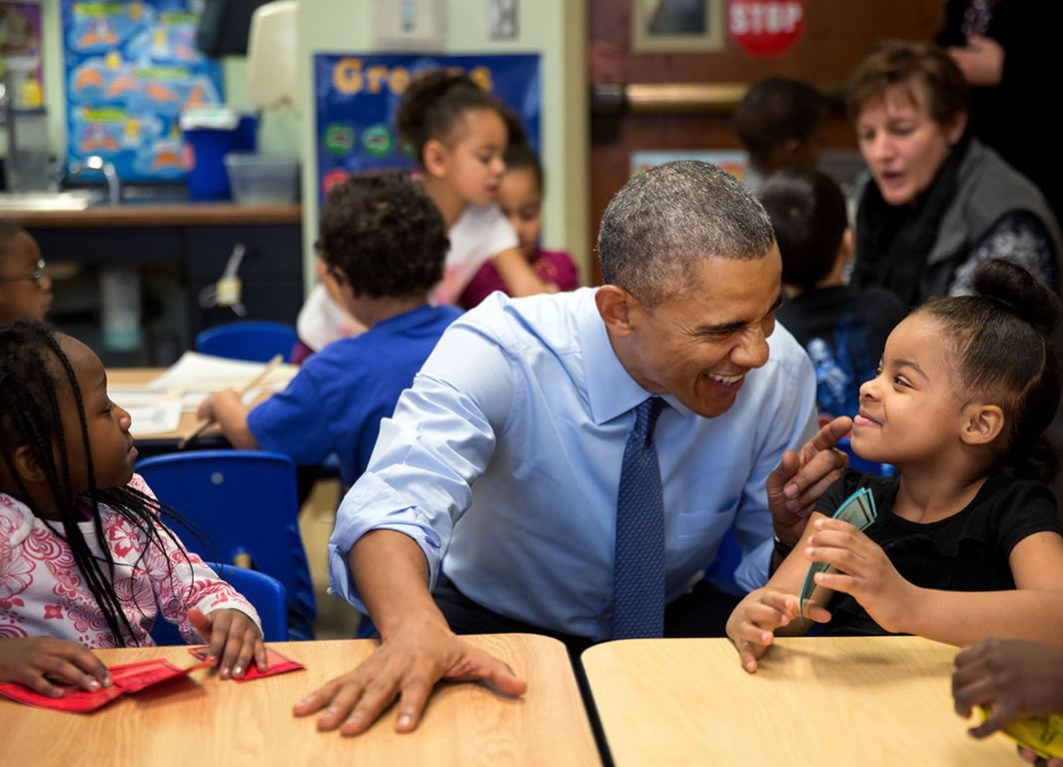Issue Insights
State of the Union 2016, Education Analysis
January 13, 2016

President Barack Obama, in his final State of the Union (SOTU) address Tuesday night, touched on education issues as part of his legacy of accomplishments and his vision for the country’s future.
“We agree that real opportunity requires every American to get the education and training they need to land a good-paying job,’’ he said. Obama praised the “bipartisan reform of No Child Left Behind” as “an important start,” but he did not specifically mention its replacement, called the Every Student Succeeds Act or ESSA, which he signed into law December 10.
President Obama trumpeted record high school graduation rates, now at 82 percent nationally. Those rates vary by state, however, and are lower for black, Hispanic, and low-income students. In higher education, the president pointed to an increase in the number of engineering graduates.
Looking forward, he said to applause, “We should build on that progress, by providing Pre-K for all” and “offering every student the hands-on computer science and math classes that make them job-ready on day one.”
Congress has refused to approve the president’s plan to for universal preschool for all 4-year-olds. The First Five Years Fund, which advocates for high-quality early learning, said it was the fourth year that the president has mentioned early learning in his State of the Union address.
President Obama also underscored his administration’s “bold steps” to bring greater connectivity to America’s classrooms. The White House website noted the connectivity divide in schools has been cut by about half since 2013.
This year’s address, as advertised, focused more on vision and priorities than it did on specific programs or detailed plans of action. That was true for education as well. Obama won bipartisan applause when he said, “We should recruit and support more great teachers for our kids.” But the president offered no game plan for his final year in office.
On higher education, the president returned briefly to the theme of college affordability, which was a prominent part of the 2015 SOTU address. He urged Congress to work with him “to make college affordable for every American. Because no hard-working student should be stuck in the red.” He touted his administration’s efforts to revamp student loans and added that “we’ve actually got to cut the cost of college.” The president argued that “providing two years of community college at no cost for every responsible student” is one of the best ways to do this.
Republican Response
Republicans were quick to comment on the president’s prescriptions for education. Gov. Nikki Haley (R-SC), whose state was one of only three to repeal Common Core State Standards, delivered the official, televised GOP response. She was critical of President Obama’s approach and his record, and she outlined ways a Republican administration would move the country forward. She focused on taxes, health care, and the need to “reform education so that it works best for students, parents, and teachers—not for Washington bureaucrats and union bosses.”
Several Republican Presidential candidates weighed in on education as well. “Obama thinks education should be controlled by the federal government,” GOP presidential contender Ben Carson tweeted. “I believe we must take the fed out of education. We must revive edu.”
Reflections from the Education Community
American Federation of Teachers President Randi Weingarten, United Negro College Fund President Michael Lomax, and others quoted from the speech in social media. National Education Association President Lily Eskelsen Garcia in a statement called on policymakers “to set aside their differences and work in a bipartisan manner to address the pressing issues facing our country. We need to make college more affordable so that our students aren’t burdened by student loan debt, fix our nation’s broken immigration system, and protect our students, educators, and communities from further harm, pain and needless gun violence.”
SOTU Guests
First Lady Michelle Obama included two college students among her guests for the address in the U.S. House Chamber. Jennifer Bragdon, a 42-year-old mother and student at Austin Community College, is part of the new majority of college students in America who are older and have families or full-time jobs. Lydia Doza, who is part of three Alaskan tribes, is a college student studying software engineering and was invited for her efforts to help advocate science, technology, engineering, and math among tribal students.
In addition, Democratic Senators Elizabeth Warren of Massachusetts, Tammy Baldwin of Wisconsin, and Charles Schumer of New York were among those with college students as their guests for the address.
Microsoft CEO Satya Nadella also was among the First Lady’s guests. Microsoft has pledged $75 million over three year to support computer-science education in high schools, especially among girls and students of color.
Education excerpts from the president’s remarks:
We agree that real opportunity requires every American to get the education and training they need to land a good-paying job. The bipartisan reform of No Child Left Behind was an important start, and together, we’ve increased early childhood education, lifted high school graduation rates to new highs, and boosted graduates in fields like engineering. In the coming years, we should build on that progress, by providing Pre-K for all, offering every student the hands-on computer science and math classes that make them job-ready on day one, and we should recruit and support more great teachers for our kids.
And we have to make college affordable for every American. No hard-working student should be stuck in the red. We’ve already reduced student loan payments to ten percent of a borrower’s income. And that’s good. Now, we’ve actually got to cut the cost of college. Providing two years of community college at no cost for every responsible student is one of the best ways to do that, and I’m going to keep fighting to get that started this year.
Social Media + SOTU
On Google, the policy issues most searched in the week leading up to the SOTU were taxes, education, healthcare, immigration, and gun control. Top social media conversations during the speech differed slightly, with education less prominent—primarily because the issue played a smaller role in President Obama’s remarks this year.
The State of the Union has generated progressively more tweets each year. In 2016, on the day of the speech, there were over 2.2 million tweets worldwide, with about 57,000 tweets related to education (as of 8:00 p.m. PT).
Overall, the conversation around education was positive—focusing on college access and affordability, as well as the president’s assertion that real opportunity comes from education and training.
Below are some of the most-shared conversations on education in connection to the president’s speech.
- @NathanZed: Obama: We have to make college affordable for every American my bank account: https://t.co/z9YwK5bpQQ (2.5K retweets)
- @BarackObama: Students should be able to get an education without taking on decades’ worth of student loan debt. #SOTU https://t.co/taytxY39tM (2.5K retweets)
- @BarackObama: “We have to make college affordable for every American.” —President Obama #CollegeOpportunity #SOTU (2.1K retweets)
- @BarackObama: “We should recruit and support more great teachers for our kids.” —President Obama #SOTU (1.8K retweets)
- @CNN: @POTUS, “We have to make college affordable for every American” followed by a standing ovation #SOTU https://t.co/7aPR5MNgWf (970 retweets)
- @WhiteHouse: “We have to make college affordable for every American.” —@POTUS #SOTU https://t.co/Xp8MqFLOm2 (810 retweets)
- @WhiteHouse: “We’ve already reduced student loan payments to 10% of a graduate’s income.” —@POTUS #SOTU https://t.co/XEIisIgoUO (520 retweets)
In 2015, by comparison, there were 2.6 million tweets on the State of the Union. Topics that received the most attention in 2015 were community college, equal pay, climate change, tax reform, and healthcare.
White House Social Media Approach
The term “State of the Union” began trending on Twitter and Facebook even before President Obama’s speech started, due in large part to the expanded interactive experience offered by the White House this year.
The nationally broadcast speech also was shown on the White House website, a White House YouTube channel, and Amazon’s online video service—a new addition this year. The president previewed his remarks on Facebook, shared his speech through Medium, and the White House’s SOTU page featured shareable graphics with information and statistics.
To try to engage young people and millennials, the White House made its debut on Snapchat. The president is also heading to YouTube on Friday to do three interviews with YouTube celebrities.






